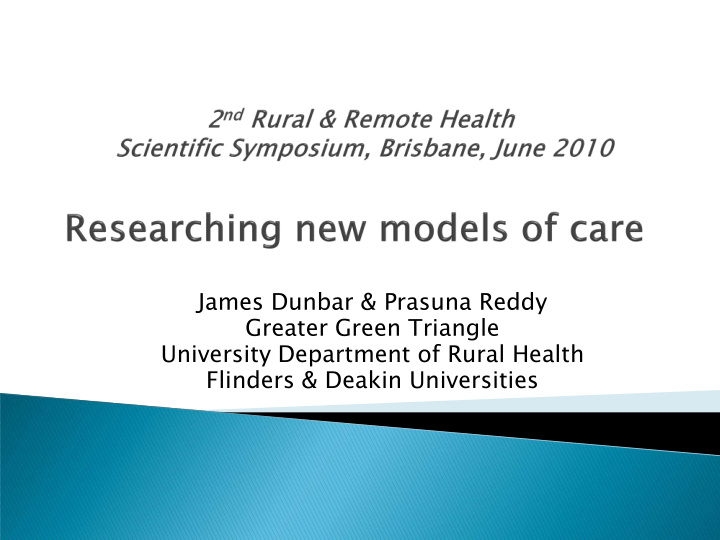



James Dunbar & Prasuna Reddy Greater Green Triangle University Department of Rural Health Flinders & Deakin Universities
In the presence of a chronic disease, depression is under diagnosed and under treated despite clear evidence that depression is a risk factor for poor outcome. WHO states that two thirds of this depression is missed in normal consulting. There is a real need to address co-morbid depression.
International studies have shown: ◦ 19.8% of TD2M patients have Major Depressive order 8 ◦ 18.9 % of T2DM Patients have Coronary Heart disease 8 ◦ 14% of patients with Chronic Heart disease have major depression, 20% have minor depression 9 8 Jurado et al, ‘Prevalence of cardiovascular disease and risk factors in a type 2 diabetic population of the North Catalonia diabetes study’, Diabetologia , vol. 46 S2, A365-366, 2004 9 Blumenthal JA, ‘Depression and coronary heart disease: association and implications for treatment’, Cleveland Clinic Journal of Medicine , vol 75 suppl 2, pg S48-53, 2008
Data from 10 general practices in Victoria Patients with depression (PHQ-9 >5) more likely to ◦ be on insulin, use health services, have complications, raised anxiety levels, poor social connectedness, smoke, low levels of physical activity Most had not been identified or treated for depression Roughly half of all patients were not in range for HbA1c, cholesterol or blood pressure Majority of patients did not know target ranges
True Blue Project Aims to provide a complete system of care involving practice nurses to improve: • Detection and management of co- morbid depression in general practice settings; • Health outcomes for patients with diabetes, heart disease and co-morbid depression; • Organisation of collaborative care in Australian general practice.
Phases of complex intervention Rural & Metro Rural GGT Practices IMPACT practices SA VIC Collab Care NSW Continuum of increasing evidence Medical Research Council: A Framework for development and evaluation of RCTs for complex interventions to improve health: April 2000
Based on the IMPACT method from University of Washington, Seattle, USA Recognises depression as a complicating factor in chronic disease management Patients are screened for depression using PHQ-9 Licence from IMPACT to Australianise the model Nurse as Case manager coordinates visits to dieticians, psychologists, podiatrists and other health professionals
Phases of complex intervention Rural & Metro Rural GGT Practices IMPACT practices SA VIC Collab Care NSW Continuum of increasing evidence Medical Research Council: A Framework for development and evaluation of RCTs for complex interventions to improve health: April 2000
Relation between context, problem definition, intervention, and evaluation for complex interventions
GPs and Practice Nurses enlisted from 6 rural practices Training program, electronic data searching and protocols developed Patients with diabetes or heart disease identified from disease registries and screened for depression. Of 322 participants, 34% had high PHQ-9 scores. Follow up after 3 to 6 months, depending on risk assessment and individual clinic preferences. At recall, some depression scores had improved. Some clinics did not recall patients because they prioritised new patients as having the most to gain by attending a nurse-led clinic.
◦ The IMPACT method could be successfully Australianised. ◦ Both GPs and nurses showed high acceptance of the collaborative model. ◦ There was a good clinical and a good business case for the collaborative model. ◦ The practices continued with collaborative care after the project finished. ◦ There was sufficient evidence to proceed to a randomised controlled trial.
Phases of complex intervention Rural & Metro Rural GGT Practices IMPACT practices SA VIC Collab Care NSW Continuum of increasing evidence Medical Research Council: A Framework for development and evaluation of RCTs for complex interventions to improve health: April 2000
TrueBlue project research question: ◦ Does pro-active intervention lead to improved patient outcomes? Recruits patients on registers with diabetes or heart disease who respond with scores > 5 on PHQ-9. Among the first studies of depression management alongside diabetes and heart disease management. Quantitative and qualitative data on process of care, quality of care (quality of goals and adherence to guidelines), depression (PHQ-9), lifestyle, cardiovascular risk.
Northern Rivers West and South Adelaide Melbourne
Nurse-led collaborative-care approach ◦ Use PHQ-9 to detect and monitor depression. ◦ Guidelines for diabetes and CHD management. ◦ Coordinating follow up and referrals. ◦ Goal setting, problem solving, lifestyle modification, risk factors, information materials. ◦ Crisis management including suicide risk protocol. Funded at the clinic level using Medicare item numbers. ◦ Nurse-initiated GP Management Plan ◦ Nurse-initiated GP Mental Health Plan ◦ Team Care Arrangement
45-minute appointments with practice nurses. Patients complete lifestyle questionnaire and PHQ-9 Usual physiological parameters measured by practice nurse. Patients develop up to three personal goals in consultation with the practice nurse linked to improved health outcomes. Appointment made with GP to complete GP Management Plan.
Practices recall patients every three months over a twelve-month period to review their GP medical plans. Patient goals are updated based on what happened over the three-month period.
There is a high acceptance of the collaborative model by GPs and nurses. Practice income from Medicare is anticipated to more than cover the nurse consulting time. 30 patients identified as at risk of suicide. Protocols audited for compliance.
50 50 45 45 40 40 35 35 30 30 25 25 20 20 15 15 10 10 5 0 >50% Improved Not Improved <50% Improved
Pr Project oject Te Team Professor James Dunbar Professor Prasuna Reddy Professor Jeff Fuller Dr Mark Morgan Dr Michael Coates Bob Leahy Great ater er Green en Triangl angle Univ iver ersit sity Depart rtmen ment t of Rural al Healt lth Flinde inders and Deakin kin Univer ersitie sities
Recommend
More recommend